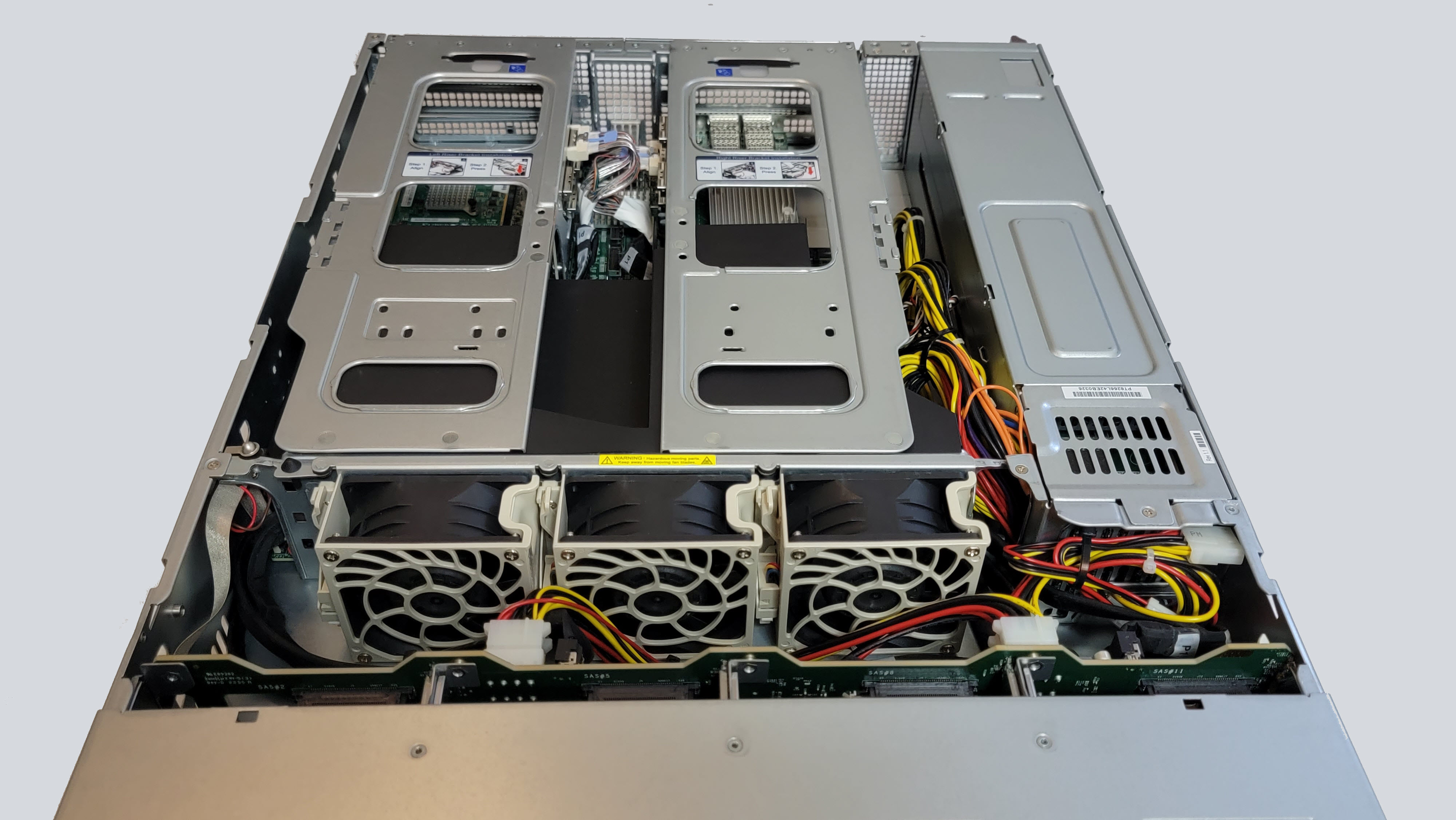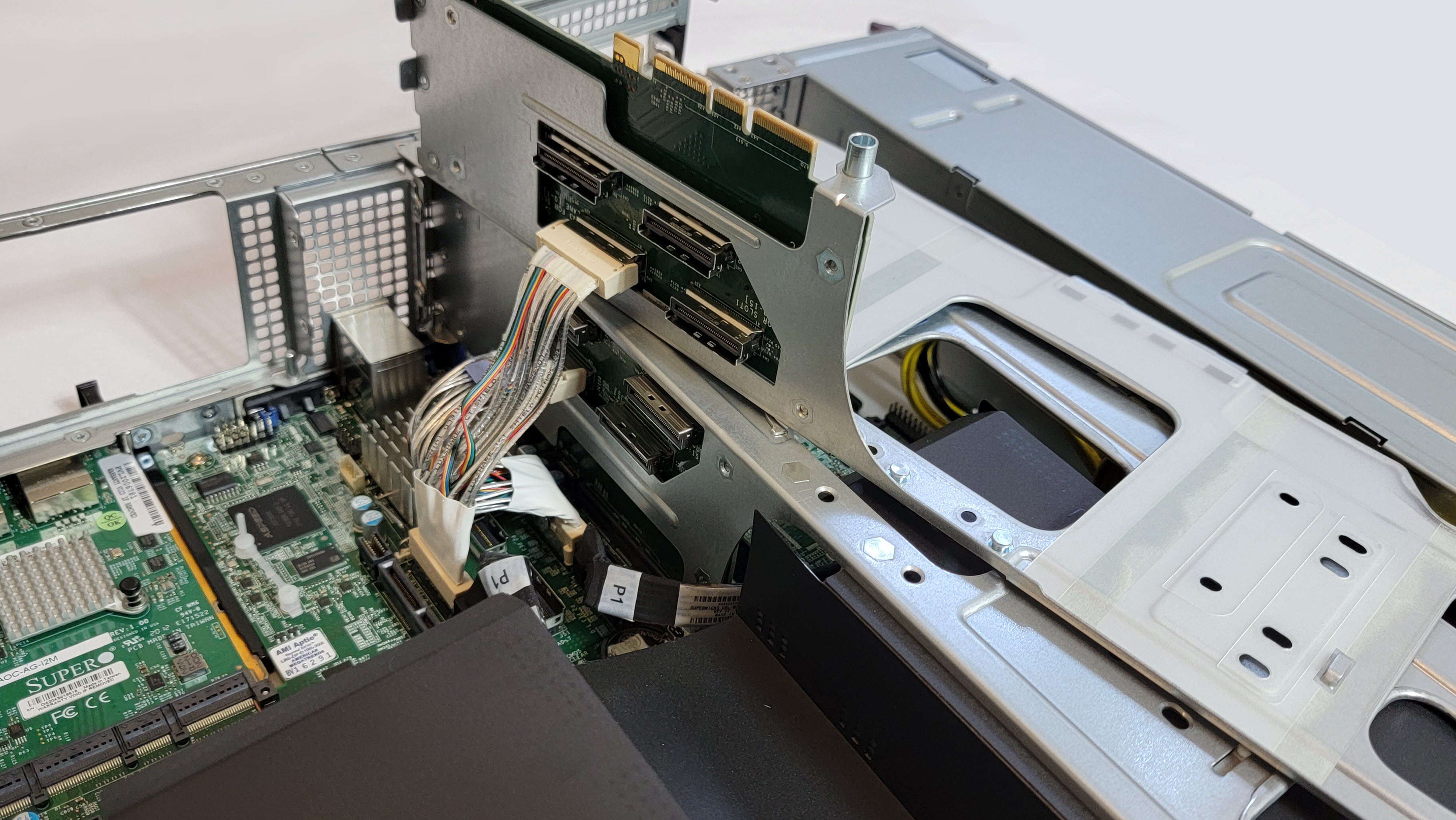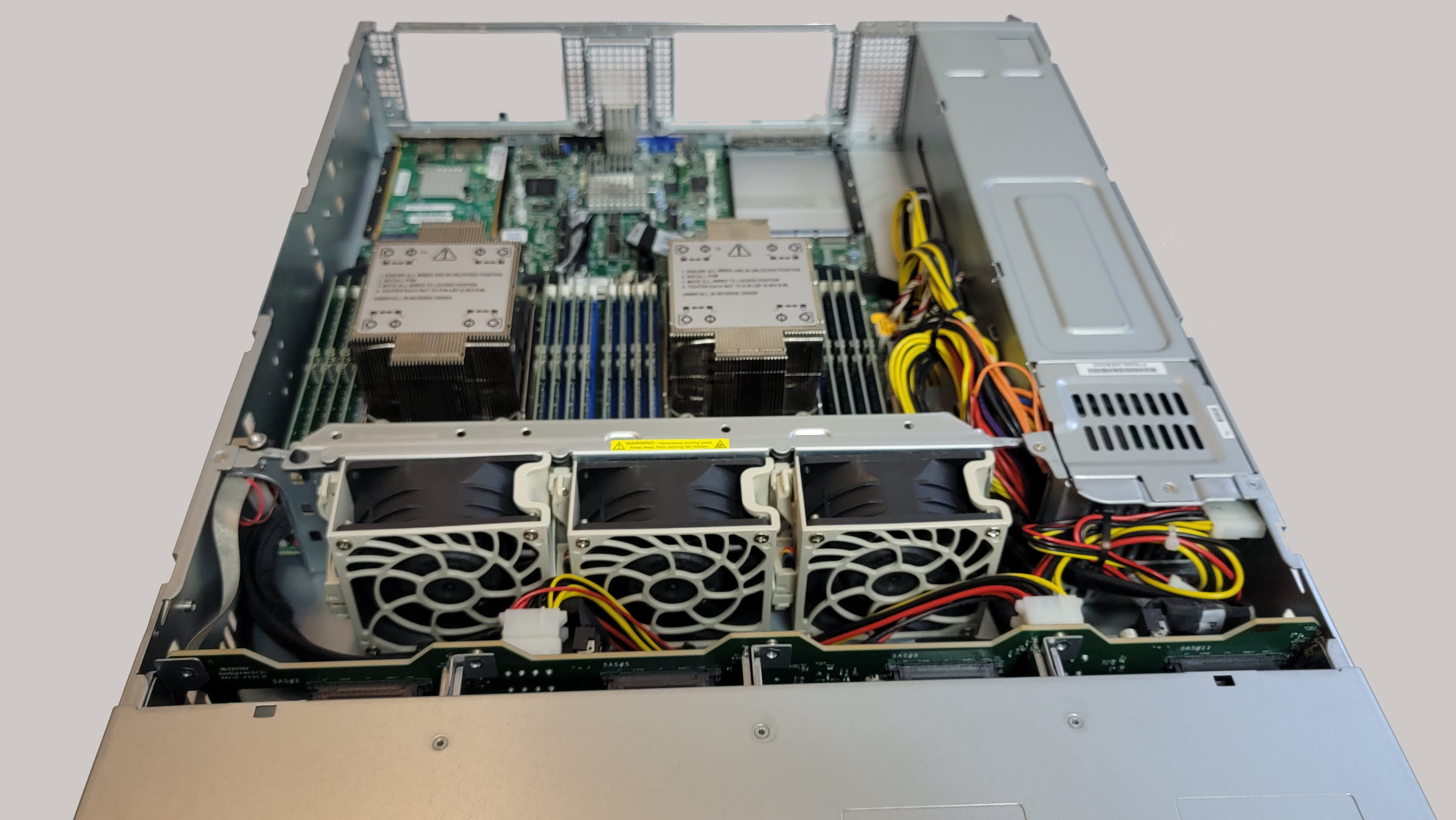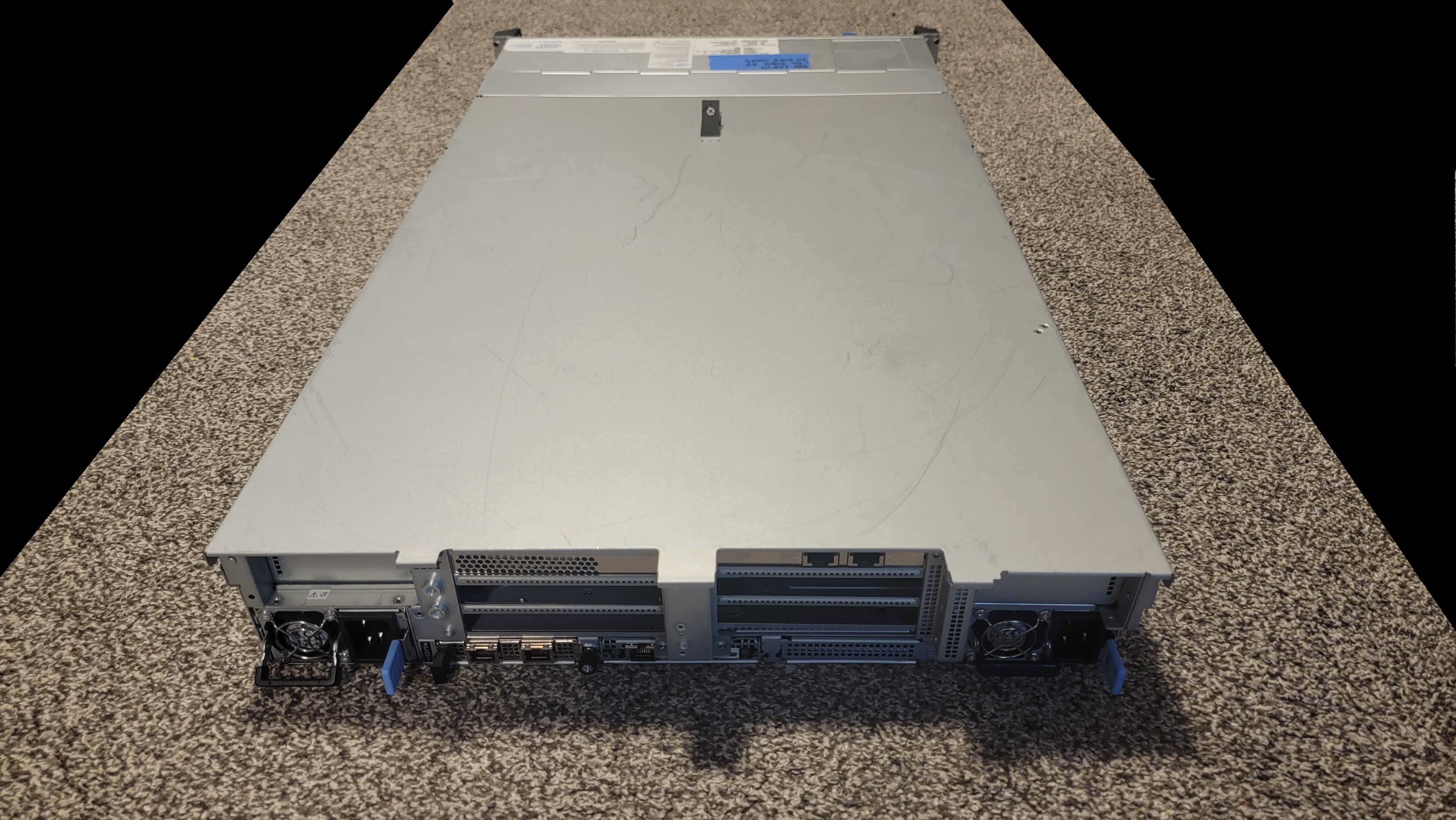Why you can trust Tom's Hardware
We tested most of the Intel Emerald Rapids and Sapphire Rapids processors with an Intel Software Development Platform based on a Quanta Rack Mount 2S 2U server. Supermicro also loaned us a very capable Supermicro SYS-621C-TN12R server so we could add the Xeon Platinum 8468 to our test pool. All of our Xeon 8468 test results are generated with this system. We tested the Genoa processors with the Titanite system outlined here.













We used the Supermicro SYS-621C-TN12R server to validate our new suite of benchmarks prior to receiving the new Intel hardware. We've run thousands of tests on Supermicro's platform encompassing all types of workloads, from the latest AI models to the heaviest parallel supercomputing workloads, and it has proven to be an effective general-purpose workhorse that provides sufficient power and cooling to extract the utmost performance from the Sapphire Rapids processors (and the RAM) we used for testing.
Due to the forward compatibility of the Eagle Stream platform, this system also serves as a good litmus for a production-class system for both Emerald Rapids and Sapphire Rapids. As with all of Supermicro's existing Sapphire Rapids platforms, this system will support Emerald Rapids after a BIOS update. Naturally, most large-scale data center operators wouldn't bother updating CPUs on an existing deployment, but Supermicro will also release a new lineup of systems based on similar designs.
This configurable 350W 2U system supports up to 12 NVMe, SAS, or SATA drives and also has provisions for 2.5-inch drive bays on the rear — that's in addition to the two M.2 ports on the motherboard. Two riser cards support up to two PCIe 5.0 x16 and two PCIe 4.0 x8 slots, with the latter configurable to also support an additional two PCIe 5.0 x16 connections.
The system also supports two full-height, full-length GPUs and an OCP 3.0 NIC. The system is fed by two hot-swappable redundant power supplies and sports 16 DDR5 slots across the underlying X13DDW-A motherboard. Other amenities include a wide range of connectivity options, including two USB 3.0 ports, one dedicated IPMI port, one COM port, and one VGA port on the rear of the chassis.





We used an Intel Software Development Platform to test the bulk of the Intel processors in our test pool. As with most development platforms, this system is not optimized for efficient power use, but the Quanta system with the Eagle Stream platform does provide exceptional cooling capability for the highest-TDP processors, thus ensuring a stable foundation for performance testing. It also comes armed with dual redundant hot-plug Titanium 2600W PSUs.
| Test Platform | Memory | Tested Processors |
|---|---|---|
| Intel Software Development Platform — Quanta Rack Mount 2S 2U | 16x 64GB (1TB) DDR5-5600 ECC (EMR) - SPR 16x DDR5-4800 (1TB) | Intel Xeon 8592+, 8480+, 8490H, 8462Y+ |
| Supermicro SYS-621C-TN12R | 16x 32GB (512GB) Supermicro ECC DDR5-4800 | Intel Xeon Platinum 8468 (SPR) |
| 2P AMD Titanite Reference Platform | 24x 64GB (1.5TB) Samsung ECC DDR5-4800 | AMD EPYC Genoa 9654, 9554, 9374F, Bergamo 9754 |
- MORE: Best CPUs for Gaming
- MORE: CPU Benchmark Hierarchy
- MORE: AMD vs Intel
Get Tom's Hardware's best news and in-depth reviews, straight to your inbox.
Current page: Supermicro SYS-621C-TN12R server, Test Systems and Setup
Prev Page Intel Emerald Rapids 5th-Gen Xeon Platinum 8592+ Next Page Intel Fifth-Gen Xeon Emerald Rapids Server Benchmarks
Paul Alcorn is the Editor-in-Chief for Tom's Hardware US. He also writes news and reviews on CPUs, storage, and enterprise hardware.
-
Tech0000 Thank you for the write article!Reply
1. correction: 2nd table first page Intel Xeon 8462Y+ (SPR) price should be the same as 8562Y+ (EMR) price = $5,945. Right now (11.22pst) you have Intel Xeon 8462Y+ (SPR) priced at $3,583 - which is wrong.
2. I would have liked to see the comparison between EMR and SPR for the same model, e.g. 8462Y+ vs 8562Y+ to better understand and isolate the generational core for core and model improvement (mostly everything else being equal). It's hard to derive conclusions, when you are comparing different models and core configs with test results numbers allover the place - one winning over the other depending on the test performed.
I suspect that a 8462Y+ vs 8562Y+ comparison would result net very modest gain (due marginally higher all core turbo) and that the real performance gains are in top tier SKUs with triple L3 cache, accepting faster DDR5 etc.
3. As a workstation ship the single socket 8558U seams to be pretty good "value" (relative to the other intel SKUs) actually. $3720 for a 48 core chip with 250GB L3 cache is not too bad for a corporate WS. Not as capable (in terms of accelerators) as the other loaded high end pricy SKUs, but for 48 cores at $77/core it is pretty good. Maybe this chip can be packaged and used as a candidate Xeon W9-3585X or similar chip... -
thestryker I'm assuming a chunk of the losses are due to Zen 4 being much more efficient but it would be nice to see some clock graphs (not for every test, but maybe one per category) if possible. If that isn't possible maybe running this same suite on a 13900K/14900K and 7950X to give some context since these are extremely close in threaded performance despite Intel using more power.Reply
Appreciate the immediate look and hope to see some more, or maybe some Xeon W review action when those EMR refreshes come out! -
tamalero Reply
Whats with these "you can trust our review made by pros" ?Admin said:We put Intel’s fifth-gen Emerald Rapids Xeon Platinum 8592+ through the benchmark paces against AMD's EPYC Genoa to see which server chips come out the winner.
Intel 'Emerald Rapids' 5th-Gen Xeon Platinum 8592+ Review: 64 Cores, Tripled L3 Cache and Faster Memory Deliver Impressive AI Performance : Read more
The first one I've ever seen do that thing was Gamer Nexus.
Now seems everyone wants to add those kind of "claims" on their own reviews. -
bit_user Thanks for the review, as always!Reply
Some more potential cons:
Still significantly lagging Genoa on energy-efficiency.
PCIe deficit in 1P configurations (80 Emerald Rapids vs. 128 lanes for Genoa). In 2P configurations, Genoa can run at either 128 or match Emerald Rapids' 160 lanes, if you reduce the inter-processor links to just 3.
Fewer memory channels (8 vs. 12 for Genoa), though the number of channels per-core is the same.
The 96-core EPYC Genoa 9654 surprisingly falls to the bottom of the chart in all three of the TensorFlow workloads, implying that its incredible array of chiplets might not offer the best latency and scalability for this type of model.
I did see a few such inversions in Phoronix' review, but fewer and way less severe. This should be investigated. I recommend asking AMD about it, @PaulAlcorn . It almost looks to me like you might've had a CPU heatsink poorly mounted, forgot to replace the fan shroud, or something like that. It's way worse than anything you saw in your original Genoa review, where we basically only saw inversions in stuff that didn't parallelize too well.
https://www.tomshardware.com/reviews/amd-4th-gen-epyc-genoa-9654-9554-and-9374f-review-96-cores-zen-4-and-5nm-disrupt-the-data-center/5In this review, it almost seems like the EPYC 9554 is outperforming the 9654 more often than not! -
bit_user BTW, I find it a little weird that they still don't have a monolithic version that's just 1 of XCC tiles, even as just a stepping stone, before you get down to the range of the regular MCC version.Reply
-
bit_user Reply
I'd imagine the issue is that they can only test the review samples they're sent by Intel.Tech0000 said:2. I would have liked to see the comparison between EMR and SPR for the same model, e.g. 8462Y+ vs 8562Y+ to better understand and isolate the generational core for core and model improvement (mostly everything else being equal). It's hard to derive conclusions, when you are comparing different models and core configs with test results numbers allover the place - one winning over the other depending on the test performed.
I suspect that a 8462Y+ vs 8562Y+ comparison would result net very modest gain (due marginally higher all core turbo) and that the real performance gains are in top tier SKUs with triple L3 cache, accepting faster DDR5 etc.
Phoronix tested a limited number of benchmarks with different DDR5 speeds. Seems like the faster DDR5 wasn't a huge win, but sadly none of the AI benchmarks were included. Those should've skewed the geomean a bit higher.
https://www.phoronix.com/review/intel-xeon-ddr5-5600
To make the results more applicable, I'd suggest the E-cores should be disabled.thestryker said:If that isn't possible maybe running this same suite on a 13900K/14900K and 7950X to give some context since these are extremely close in threaded performance despite Intel using more power. -
thestryker Reply
What does the XCC offer in Xeon Scalable that MCC doesn't? I was trying to think of something but the specs of all the SKUs seem so random for EMR I couldn't figure out what you'd be referring to.bit_user said:BTW, I find it a little weird that they still don't have a monolithic version that's just 1 of XCC tiles, even as just a stepping stone, before you get down to the range of the regular MCC version.
That would remove the entire point I was getting at of using the desktop parts as a comparison. The 13900K/14900K consistently go back and forth with the 7950X in MT performance at stock settings in standard CPU benchmarks despite the extra power consumption on the Intel side. Though with the IPC between RPL/Zen 4 so close maybe disabled E-cores + 1 CCD disabled would make for a good comparison as then it would be just 8 P-cores vs 8 Zen 4 cores. I haven't seen any such comparison though so this is just a wild guess.bit_user said:To make the results more applicable, I'd suggest the E-cores should be disabled. -
bit_user Reply
I just meant that perhaps they could get more mileage out of their chiplet usage. Like, maybe there are some XCC tiles with a defect in the EMIB section, so just put those on a substrate by themselves and sell it as 32C or less.thestryker said:What does the XCC offer in Xeon Scalable that MCC doesn't?
Okay, well if you don't exclude the E-cores, then I don't see how those tests would be relevant to these server CPUs.thestryker said:That would remove the entire point I was getting at of using the desktop parts as a comparison.
Heh, you might just get your chance! The new Xeon E-series 2400 have their E-cores disabled (sounds ironic, eh?). So, if anyone benchmarks a Xeon E-2488 against a Ryzen 7700X, then it'd be exactly what you're talking about.thestryker said:with the IPC between RPL/Zen 4 so close maybe disabled E-cores + 1 CCD disabled would make for a good comparison as then it would be just 8 P-cores vs 8 Zen 4 cores. I haven't seen any such comparison though so this is just a wild guess.
Annoyingly (for me), the new Xeon E 2400 also have their GPUs disabled. Otherwise, I might've been interested. I guess they could still announce G-versions, later. -
thestryker Reply
Ah yeah I get what you mean, but they'd be limited to 4 memory channels and half the PCIe lanes as well. I would love to know what happens in that circumstance though... like do they have to toss the whole thing?bit_user said:I just meant that perhaps they could get more mileage out of their chiplet usage. Like, maybe there are some XCC tiles with a defect in the EMIB section, so just put those on a substrate by themselves and sell it as 32C or less.
Well like I said originally it's more to give a known quantity comparison than it is to get a direct reflection. What I mean by this being if there was a test that Genoa beat EMR, but the desktop CPUs were closer/equal you could extrapolate that the server CPU differences were more likely due to efficiency than architecture. It would definitely be much better if you had a P-core only setup which matched a Zen 4 setup in performance though for this comparison.bit_user said:Okay, well if you don't exclude the E-cores, then I don't see how those tests would be relevant to these server CPUs.
Yeah that would be the ideal comparison. I'd love to see a die shot to see if they're using ones without E-cores.bit_user said:Heh, you might just get your chance! The new Xeon E-series 2400 have their E-cores disabled (sounds ironic, eh?). So, if anyone benchmarks a Xeon E-2488 against a Ryzen 7700X, then it'd be exactly what you're talking about.
Yeah I was surprised there were so many SKUs listed but none with an IGP. In the past they've always launched at least a few with graphics. Another reason why I'd love to see a die shot.bit_user said:Annoyingly (for me), the new Xeon E 2400 also have their GPUs disabled. Otherwise, I might've been interested. I guess they could still announce G-versions, later.
